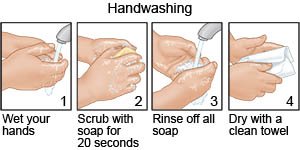Vancomycin Resistant Staphylococcus Aureus Infection
Medically reviewed by Drugs.com. Last updated on Apr 6, 2025.
What is vancomycin resistant staphylococcus aureus infection?
A vancomycin resistant staphylococcus aureus (VRSA) infection is caused by bacteria. These bacteria are resistant to the antibiotic medicine vancomycin. The infection can spread easily from person to person.
What increases my risk for a VRSA infection?
- Surgery or a hospital stay
- Certain long-term antibiotics
- Medical tubes in your body, such as an IV or central line
- A weak immune system
- Not washing your hands properly
What are the signs and symptoms of a VRSA infection?
Your signs and symptoms depend on where your infection is located. You may have any of the following:
- Red, warm skin around a wound
- Soreness, swelling, and drainage from a wound
- Fever, chills, and body aches
- Weakness
- Cough
How is a VRSA infection diagnosed?
- Blood tests will show the VRSA bacteria and help healthcare providers plan which antibiotics are best for treatment.
- A sample of your bowel movement, urine, or any wound may show VRSA bacteria.
How is a VRSA infection treated?
Antibiotics help kill the bacteria that caused your VRSA infection.
How do I prevent the spread of VRSA?
- Wash your hands often. Wash your hands several times each day. Wash after you use the bathroom, change a child's diaper, and before you prepare or eat food. Use soap and water every time. Rub your soapy hands together, lacing your fingers. Wash the front and back of your hands, and in between your fingers. Use the fingers of one hand to scrub under the fingernails of the other hand. Wash for at least 20 seconds. Rinse with warm, running water for several seconds. Then dry your hands with a clean towel or paper towel. Use hand sanitizer that contains alcohol if soap and water are not available. Do not touch your eyes, nose, or mouth without washing your hands first.

- Keep your wound clean and covered with a bandage until it is healed, or as directed.
- Do not share items. Do not share dishes, towels, or other items with anyone. Items need to be washed after you use them.
- Clean surfaces often. Use a disinfecting wipe, a single-use sponge, or a cloth you can wash and reuse. Use disinfecting cleaners if you do not have wipes. You can create a disinfecting cleaner by mixing 1 part bleach with 10 parts water. In the kitchen, clean countertops, cooking surfaces, and the fronts and insides of the microwave and refrigerator. In the bathroom, clean the toilet, the area around the toilet, the sink, the area around the sink, and faucets. Clean surfaces in the person's room, such as a desk or dresser.
- Wash contaminated laundry with hot water and soap in the washing machine. Dry them in a clothes dryer on the hot setting.
Drugs used to treat this and similar conditions
Augmentin
Augmentin is a prescription antibiotic combining amoxicillin and clavulanate to treat bacterial ...
Amoxil
Amoxil (amoxicillin) is a penicillin antibiotic used to treat many different types of infections ...
Omvoh
Omvoh is used to treat moderate to severe ulcerative colitis or Crohn's disease in adults. This ...
Azithromycin Dose Pack
Azithromycin Dose Pack is used for babesiosis, bacterial endocarditis prevention, bacterial ...
Levofloxacin
Levofloxacin is a fluoroquinolone antibiotic used to treat serious bacterial infections and prevent ...
Keflex
Keflex (cephalexin) is used to treat infections caused by bacteria, including respiratory ...
Metronidazole
Metronidazole is an antibiotic used to fight bacteria in your body. Learn about side effects ...
Ceftriaxone
Ceftriaxone systemic is used for bacteremia, bacterial endocarditis prevention, bacterial ...
Cephalexin
Cephalexin is a cephalosporin antibiotic used to treat bacterial infections like respiratory, skin ...
Ciprofloxacin
Ciprofloxacin is an antibiotic belong to a group of drugs called fluoroquinolones. Learn about side ...
When should I seek immediate care?
- You have sudden trouble breathing.
- You have a fast heartbeat or chest pain.
- You feel so dizzy that you have trouble standing up.
- Your lips and fingernails are turning blue in color.
When should I call my doctor?
- You have a fever.
- Your symptoms do not improve or are getting worse.
- You have chills, a cough, or feel weak and achy.
- You have a wound that is red, swollen, or draining pus.
- You have questions or concerns about your condition or care.
Care Agreement
You have the right to help plan your care. Learn about your health condition and how it may be treated. Discuss treatment options with your healthcare providers to decide what care you want to receive. You always have the right to refuse treatment. The above information is an educational aid only. It is not intended as medical advice for individual conditions or treatments. Talk to your doctor, nurse or pharmacist before following any medical regimen to see if it is safe and effective for you.© Copyright Merative 2025 Information is for End User's use only and may not be sold, redistributed or otherwise used for commercial purposes.
Learn more about Vancomycin Resistant Staphylococcus Aureus Infection
Care guides
Further information
Always consult your healthcare provider to ensure the information displayed on this page applies to your personal circumstances.
